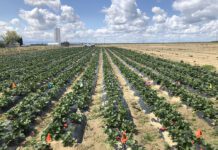As more and more technological devices and practices are developed, growers will continue to get and more sales pitches. A walk through any conference exhibit hall is a small look at the huge market that is ag technology. It is a very competitive market and these companies and developers are not only fighting for the investor’s dollar, they are competing for the growers sales dollars. Developers and their marketers must provide justification to the grower for their products. If the market is to support the product, it must have a specific benefit to the grower.
Benefits of Technology
The obvious benefit is the economic value. The grower and the investor, want to know that they will get a return on their investment. The investor wants a return along with interest and the grower wants to increase income and/or reduce costs within a two to three years span of time in which they have invested.
There are also intrinsic advantages such as comfort and ease of mind, which many growers consider when purchasing new technology. One grower invested in an autoguidance system and discovered it was far less stressful, so much so, he could have lunch in the tractor with his wife, and most importantly he was confident his employees could plant in straight rows. In speaking with him, not once did he mention how much money he saved, but that he actually enjoyed fieldwork again.
Environmental benefits that protect natural resources should be given consideration also. I believe that growers are naturally environmentalist, though many people don’t see it that way. Many of the tools that growers have used in the past have not been as environmentally friendly as hoped and one reason why they are “in the past”. Balancing economic benefits and environmental benefits for the long term is what I have always considered to be the definition of sustainability.
Technology for Regulatory Functions
Another benefit not often discussed, and thus the subject of this article, is the use of technology for regulatory functions. The US government has a long line of regulatory agencies. So the old cynical quote comes to mind, “I’m from the government and I’m here to help”.
Governmental agencies don’t make laws, but they do create the standards and regulations by which the laws are implemented. Agencies are also responsible for enforcing those standards and regulations. Most of the time we don’t recognize these regulations as beneficial (and at times there may be valid arguments to this point), but they are in place for reasons of safety, fairness, and equity.
An example of a regulatory agency is the Occupational Safety and Health Administration (OSHA), which is responsible for the safety and the health of the workers in the US. A very noble and important purpose. Laws are passed on a regular basis dealing with safety issues, however Congress and the Senate do not provide the specific details of what is to be done and how to ensure safety and health. That is left up to OSHA to create the regulations that implement the laws. These regulations are usually criteria or standards that must be met. In the case of OSHA, it involves safety devices and practices that employers must have for their employees.
The other role that agencies have is the enforcement of the regulations or laws. Enforcement is not usually in the form of an FBI agent or federal officer, it is something more dreaded… paperwork! It’s called accountability and it provides the agency proof that the regulations are being followed. Again in the case of OSHA, there are annual reports due and every time somebody is injured a report is completed. These may not be required, but if a company does not have documentation of when, where and how accidents occurred, they may be subjected to penalties.
Another example of an agency is the Food Safety and Inspection Services (FSIS) which is a part of the United States Department of Agriculture (USDA). The Farm Bill from the federal government provides the laws concerning healthy foods and the FSIS is responsibility to develop the regulations and standards to ensure those laws can be implemented and enforced. In some cases the standards are the amount of residue or quality of products. Enforcement comes in the form of inspectors that test residue on products and if it doesn’t meet the standard they have the right to take the product off the retail marketplace.
States also take responsibility for the food products that are produced within their border. The state department of agriculture often has regulations to make sure that crop inputs are being properly applied. Regulation takes the form of certification tests for persons doing the application before being allowed to buy or apply products. Applicators are also required to complete paperwork and documentation of all environmental conditions when the product was applied.
Accountability
Therefore along with regulations and various benefits provided by the government agencies comes accountability. Accountability is how an agency documents the compliance of its rules or the impact of the funds that it has expended. In what form does the government currently require accountability? Usually it is in the form of written reports that are completed by the public, people receiving the benefit, or government workers hired to collect data on compliance.
Using some of the previous examples, lets see how technology can be used to document regulatory compliance. These are not a summary or critique of current regulations, merely a reflection of how technology could be used.
Using Technology to Document Regulatory Compliance
OSHA is concerned about safety of workers and documents injuries. Documentation is required that shows that safety gear is in place; personal protective equipment (PPE) is being worn; and injuries that occur in the workplace. Use of RFID (radio frequency ID) tags with a Bluetooth or Wifi on safety gear would allow an inspector to enter a building and get a complete list of safety gear and location on a handheld tablet. An electronic counter (similar to a FITBit) on PPE would provide documentation on its use. A proximity sensor on a first aid kit would record each time it was open with a time and date stamp, to be checked against a log of injuries.
In a processing plant inspectors fill out a paper form with each lot or grouping of fruit that he takes a sample from, to document the level of residue or bacteria. Instead, a QR code is attached to each lot of fruit as it comes out of the field. As it enters the processing plant a date/time stamp is attached to the database for the QR code (quick response code). As it is tested for residue, that information is also attached to the database. Everything that is done to that food item is automatically digitally entered into the QR database. A handheld datalogger could be used to scan a QR code for the lot of fruit for confirmation of compliance and checking of results.
Most animal production facilities have to get rid of a large amount of manure. A state’s department of natural resources is usually responsible to make sure that it is spread someplace where it will not get into the groundwater or surface water. Animal production facilities are responsible for a Manure Management Plan that includes a map and how much manure was placed on each field. Growers have hand created maps and estimate the values in the past. A technological alternative is to use GIS to create a map of all the fields and GPS on the application equipment to document the time and location of all applications. If a flow meter is used, it will also document how much was applied. An as-applied map provides an accurate application rate throughout a field, knowing not only where but how much.
Applying restricted chemicals in the field requires not only a field location, but should also be time/date stamped, chemical information, and weather conditions including temperature, humidity and wind. This information is important because you are not only accountable to the government, but you are likely accountable to your neighbor. Using a GPS is a trustworthy source to document where and where the application occurred. To get weather data automatically, National Oceanic and Atmospheric Administration (NOAA) records this 24/7 and make the information available on the internet. Downloading and attaching to the application information provides the documentation that the field was sprayed properly.
These example are not at all futuristic; all of these technologies exist. Though I am not sure how many are actually being used for regulatory functions, some of them are being considered and researched. The example of the processing plant that identifies fruit going through the plant using a QR code to record all processes is known as Block Chain. It is something that will likely be expanded and adopted by more processors, not because the government requires it, but because the public wants it. People want to know where their food comes from and what has been done to it and how much energy it took to produce it. So in some cases it is not just the government demanding accountability, it is the public consumer that wants it.
Technology Usage in the Future
Will technology be used for regulatory compliance? A likely and resounding yes. Anytime in the next 10 years; that is harder to predict. There are several issues that need to be considered.
Can the government require use of technology? Currently this unlikely because its use is not common enough that everybody would have access to it. Government agencies already make it an option as is the case with the manure management plans. The regulatory agency is not going to require the use of a GIS/GPS for manure management plans, but some consultants offer GIS and GPS services to create a plan and then annually update it.
Weighing the Pros and Cons
Another related concern… is Big Brother watching? The concept of the government watching our every move was originally created in the George Orwell book “1984”. Do I really wanting OSHA to know every time I open the first aid kit to get a bandage for a papercut? I don’t! How about a live video feed showing that you are indeed wearing your safety harness and safety glasses. Would you rather have a governmental inspector come out to your business or have data automatically sent to them?
Is it worth it? What would it cost to put a sensor on every first aid kit? This needs to be compared to the cost hiring a person to travel to every job site to check and confirm compliance. This in turn needs to be compared to the cost of non-compliance, which is lack of data about accidents in the workplace and a missed chance to improve safety.
Use of technology for regulatory agencies for documentation of compliance does have advantages: automated data collection; accuracy and transfer of data; digital format that can be easier to summarize and analyze; and documentation of time/date/location with GPS. Concerns of privacy and costs need to be addressed.
















